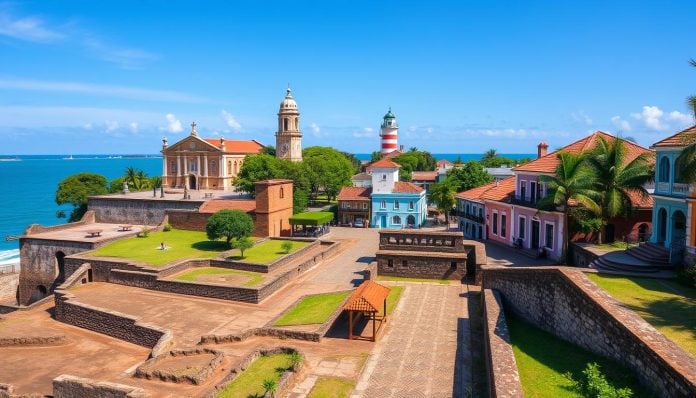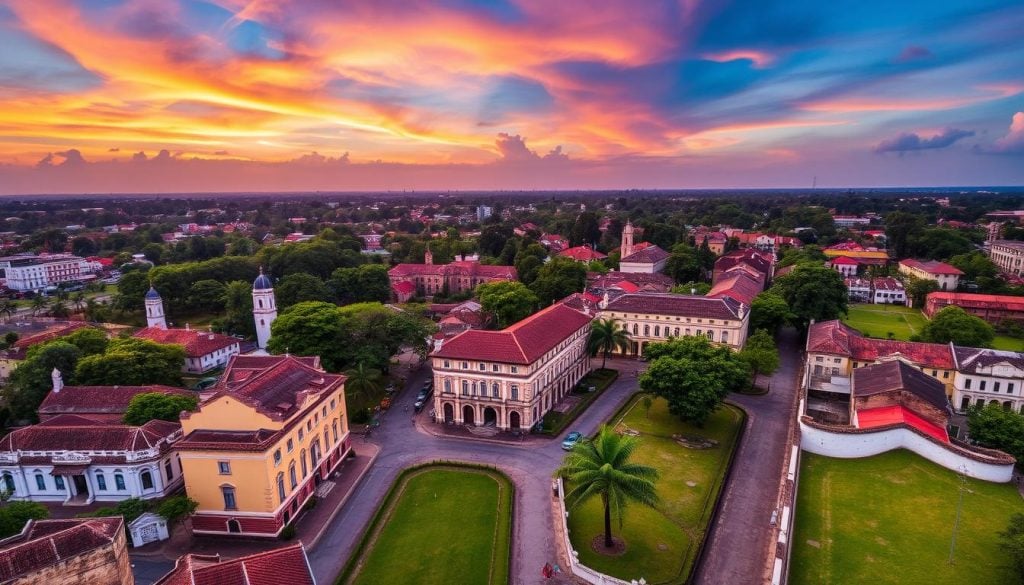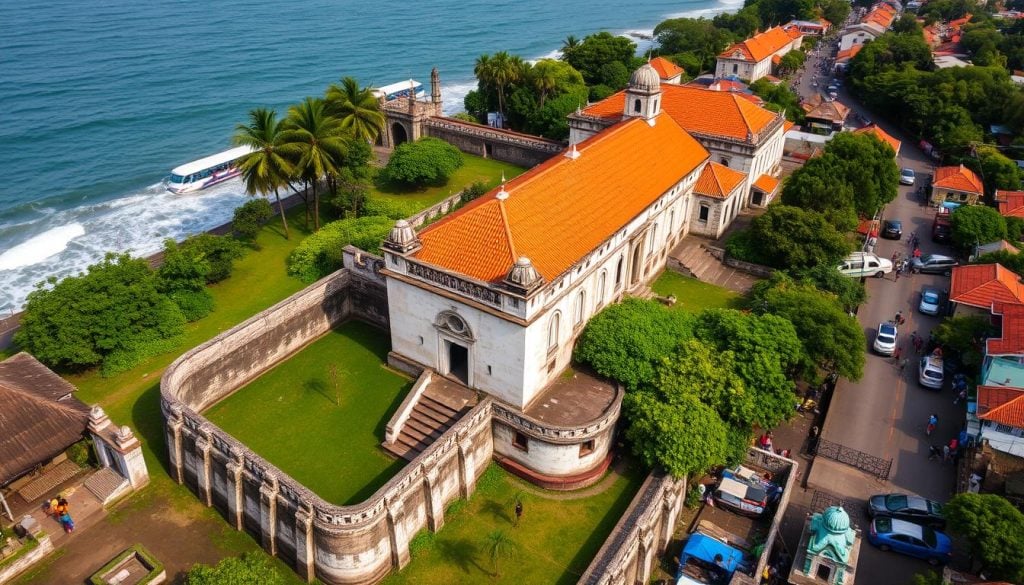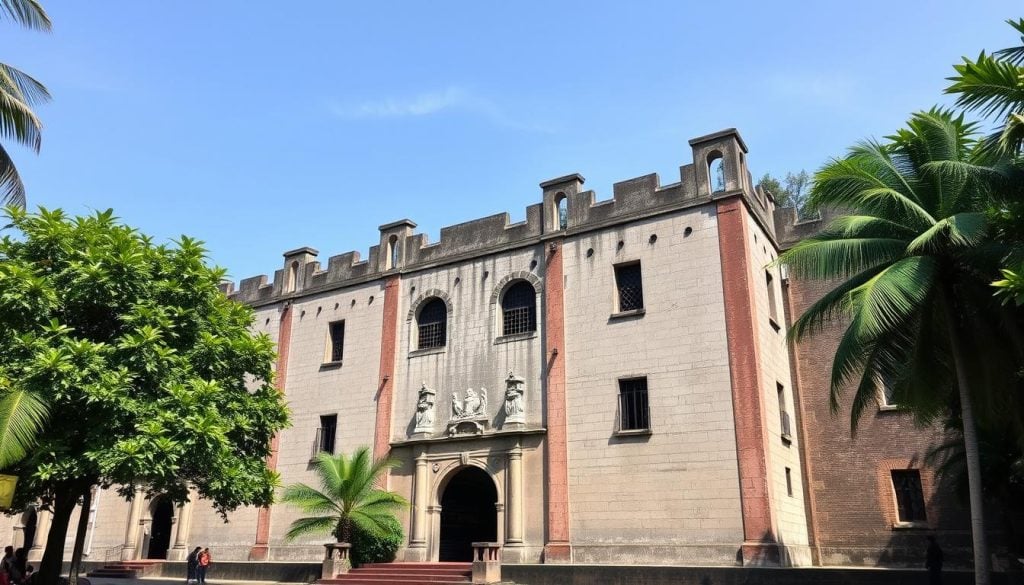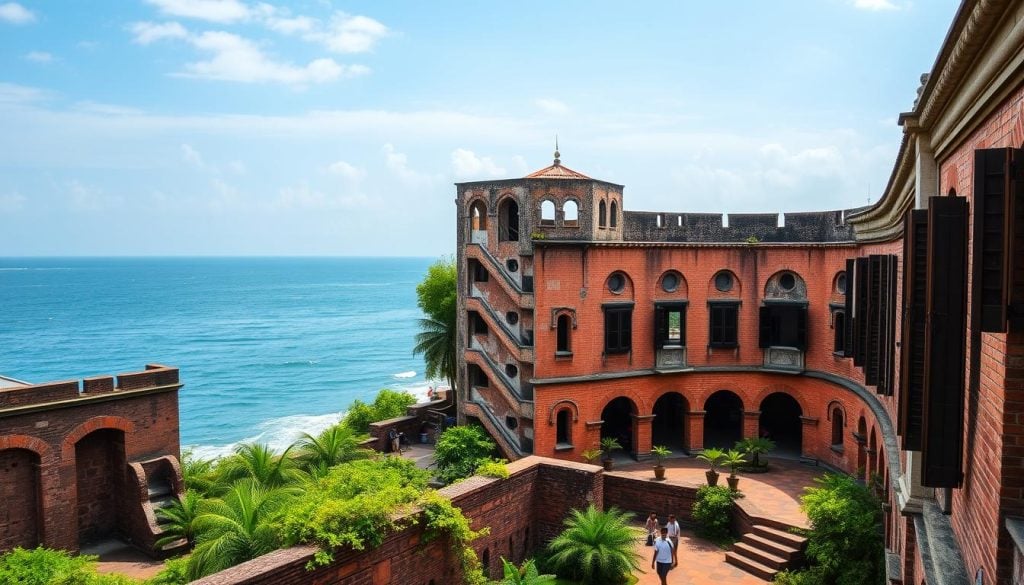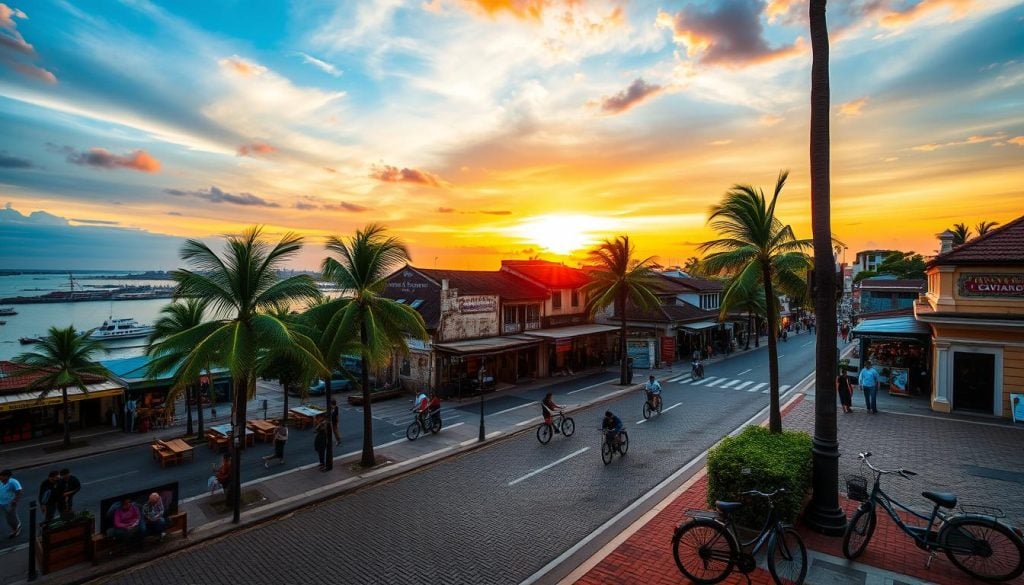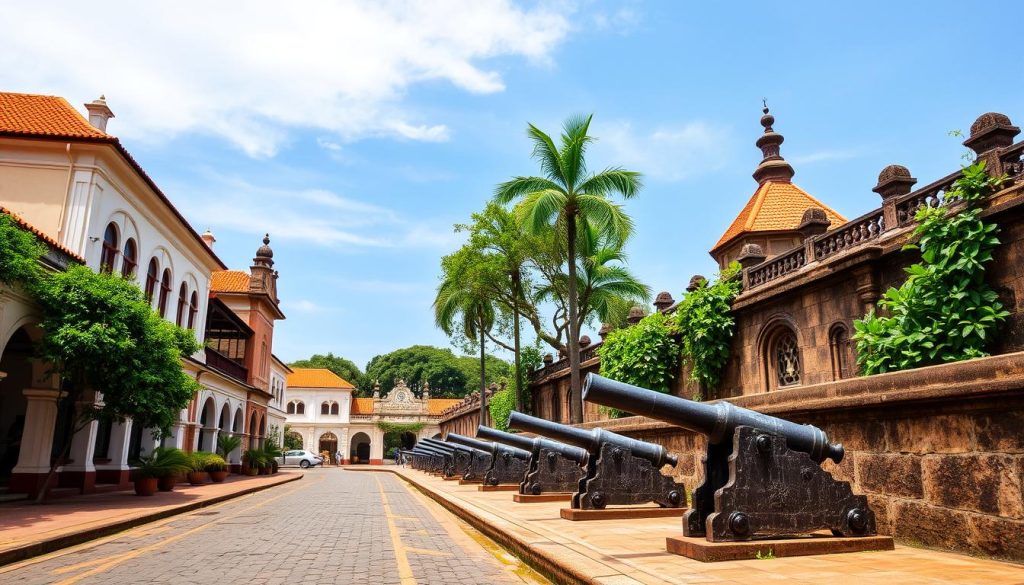Have you ever wondered how a single area can hold centuries of trade and conflict? It reveals the hidden stories of colonial history.
Colombo’s Dutch Fort is more than a place to visit. It’s a journey into Sri Lanka’s colonial past. The Portuguese started it, and the Dutch fortified it in the 17th century. Here, you’ll see how cultures mixed, changing architecture and society.
Inside, you’ll find historical sites that tell stories of trade and defense. These sites are a must-see for anyone interested in history. They will captivate every history lover and curious traveler.
A Brief History of Colombo’s Dutch Fort
The Fort of Colombo has a rich and dynamic past. It was first built by the Portuguese in the 16th century. It showed the strategic importance of the location.
In the 17th century, the Dutch influence in Sri Lanka grew. They made big changes and added to the fort. This made it a key trading port in the Indian Ocean.
The fort was important for many colonial powers. The Dutch made it stronger for trade and military needs. Later, the British took over and made more changes. By the late 19th century, many parts of the fort were torn down for city growth.
Even with these changes, parts of the fort still stand. They tell the story of the past and the Dutch impact on Sri Lanka. Each stone and structure has a story of colonial times and different cultures.
Must-see historical sites in Colombo’s Dutch Fort?
The Dutch Fort area in Colombo is filled with historical sites. These sites show the city’s colonial past. The Delft Gate Colombo and Battenburg Battery are key attractions.
Delft Gate: A Glimpse into the Past
Delft Gate is a key entrance to the fort. It was built to protect the area. Today, it lets visitors see Colombo’s rich history.
Battenburg Battery: Coastal Defenses
The Battenburg Battery shows the fort’s military side. It was built to fight off sea attacks. Now, it tells a story of Colombo’s defense history.
Exploring the Fortified Warehouse
The Fortified Warehouse in Colombo is key to the city’s maritime history. It was built with strong masonry to withstand sieges. Now, it’s the Maritime Museum Colombo, showing its journey from a trade center to a cultural gem.
The Maritime Museum
This museum has many artifacts and models. They tell the story of Colombo’s harbor growth. Visitors see exhibits on sea traditions and the economy that shaped the area. It shows how important it is to keep maritime history alive.
Architectural Significance
The Fortified Warehouse’s design is a clear sign of Dutch colonial architecture. Its double-barrel roofs are unique. This building was not just useful but also showed the importance of coastal trade back then.
Visiting Colombo’s Historic Landmarks
Exploring Colombo’s vibrant culture leads you to two key landmarks: the Old Colombo Dutch Hospital and the National Museum of Colombo. Each spot offers a unique look into Sri Lanka’s rich heritage. They show the country’s past and present.
Old Colombo Dutch Hospital
The Old Colombo Dutch Hospital is one of the oldest buildings from the colonial era, dating back to the 1600s. Today, it’s a place for dining and shopping, blending old and new. You can see its preserved façade while enjoying a meal or buying local crafts.
Its transformation into a commercial space highlights its historical value and modern appeal.
National Museum of Colombo
Close by, the National Museum of Colombo adds to your journey through Sri Lanka’s heritage. It houses a vast collection of royal artifacts, ancient sculptures, and exhibits on the country’s history. You’ll dive into centuries of art and culture, learning about the people and events that shaped Sri Lanka.
Visiting both the Old Colombo Dutch Hospital and the National Museum of Colombo gives you a full picture of Colombo’s diverse cultures and histories.
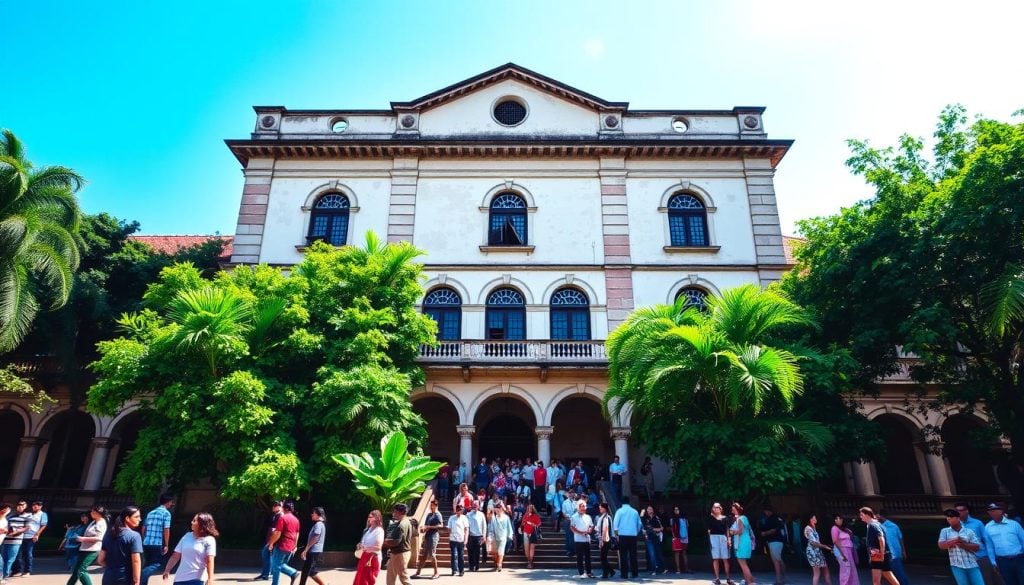
Colonial Architecture in Sri Lanka
The buildings in Sri Lanka tell a story of its colonial past. They show the styles of the Dutch and British, mixing local and foreign influences. This mix makes the architecture unique.
The Dutch architectural influence is clear in many places. The Old Colombo Dutch Hospital is a great example. It shows how European designs and local skills came together.
These old buildings in Colombo help us see how the city grew. They show the creativity of the past and give us a peek into old times. Today, they draw visitors who want to see how colonial times shaped Sri Lanka.
| Architectural Feature | Dutch Influence | British Influence |
|---|---|---|
| Facade Style | Wide verandas, ornate gables | Symmetrical designs, turrets |
| Materials | Coral stone, local timber | Brick, iron |
| Roofs | Steeply pitched | Flat roofs with parapets |
| Windows | Large, decorative | Paneled and bay windows |
Looking at these features, we see the beauty and complexity of Sri Lanka’s colonial architecture. It shows the history that still matters today.
Must-Visit Attractions in the Fort Area
The Fort area in Colombo is full of history, architecture, and culture. It has two main attractions that stand out. Each offers a unique view of heritage and creativity.
Geoffrey Bawa House
The Geoffrey Bawa House is a must-see for architecture lovers. It was once the home of famous architect Geoffrey Bawa. The house beautifully combines design with nature.
Inside, you’ll find lots of natural light and local art. This art shows off Sri Lanka’s culture. Walking through, you’ll see the creativity that makes this place special.
Economic History Museum of Sri Lanka
The Economic History Museum of Sri Lanka gives you a peek into the country’s economic past. It’s in a historic colonial building. The museum has exhibits that show how Sri Lanka’s economy has changed over time.
This helps you understand the region’s heritage and its link to today. The Geoffrey Bawa House and the Economic History Museum are key landmarks. They make your visit to the Fort area even more enriching.

Things to Do in Dutch Fort
Exploring Dutch Fort offers a wealth of activities. It’s perfect for those who love history and local culture. Start by visiting the vibrant markets in Pettah district. Here, you can try traditional foods and find unique souvenirs.
Joining guided tours is a great idea. They offer deep insights into the area’s history. These activities in Colombo Fort include visits to key historical sites, enriching your experience.
For a calm moment, take a walk along the waterfront. The views of the harbor are stunning, ideal for relaxation. If you’re interested in local culture, try culinary classes or craft workshops. They offer unique experiences that go beyond just seeing sights.
The table below lists some top activities to make your visit to Colombo memorable:
| Activity | Description | Location |
|---|---|---|
| Market Exploration | Sample local foods and shop for souvenirs. | Pettah District |
| Guided Historical Tours | Learn about the history of Dutch Fort. | Colombo Fort Area |
| Waterfront Walks | Enjoy scenic harbor views. | Promenade |
| Culinary Classes | Discover traditional Sri Lankan cooking. | Local Workshops |
| Craft Workshops | Engage in local handicrafts. | Dutch Fort |
Cultural Heritage Sites in Colombo
The vibrant cultural heritage sites in Colombo offer a deep look into Sri Lanka’s history and culture. Exploring these sites is a unique chance to see the best of heritage tourism in Sri Lanka. Each place has its own story, mixing colonial and local traditions.
The Pettah Hindu Temple is a standout, with its detailed carvings. It shows the city’s diverse religious life. The Old Colombo Dutch Hospital is another gem, blending colonial architecture with local history. It tells a rich story of the area.
These sites draw tourists and are key to the community’s identity. They show how the city has grown over time. They are perfect for anyone wanting to learn about Colombo’s past and present.
| Site Name | Description | Significance |
|---|---|---|
| Pettah Hindu Temple | A colorful temple famous for its detailed carvings and vibrant rituals. | Represents the cultural diversity and spiritual practices of Colombo. |
| Old Colombo Dutch Hospital | Colonial-era building converted into a shopping and dining precinct. | Symbolizes the city’s colonial past and its adaptive reuse in modern times. |
| National Museum of Colombo | Home to a vast collection of Sri Lankan artifacts and art. | Essential for understanding the historical context and cultural lineage of Sri Lanka. |
| Independence Memorial Hall | A national monument celebrating Sri Lanka’s independence. | A focal point for national pride and important celebrations. |
Keeping these sites preserved is key to boosting heritage tourism in Sri Lanka. Visitors gain a deeper respect for the history that makes this city so vibrant.
Conclusion
Exploring Colombo’s Dutch Fort is a thrilling way to see the area’s rich history. The historical sites in Colombo are not just old buildings. They tell stories of colonial times and how Sri Lankan culture has grown.
Every visit to these sites lets you connect with the past. Places like Delft Gate and the Maritime Museum show the strength and creativity of earlier times.
Walking through the Fort area, you’ll see amazing architecture and learn about Colombo’s culture. The preserved buildings and their stories make your visit special. You’ll understand Sri Lanka’s heritage better with each step.
Exploring Colombo’s Dutch Fort is more than just looking at old buildings. It’s about diving into history, seeing art, and remembering a strong people. Plan your visit to Colombo and discover its historical sites. Your trip will stay with you long after you leave.

































